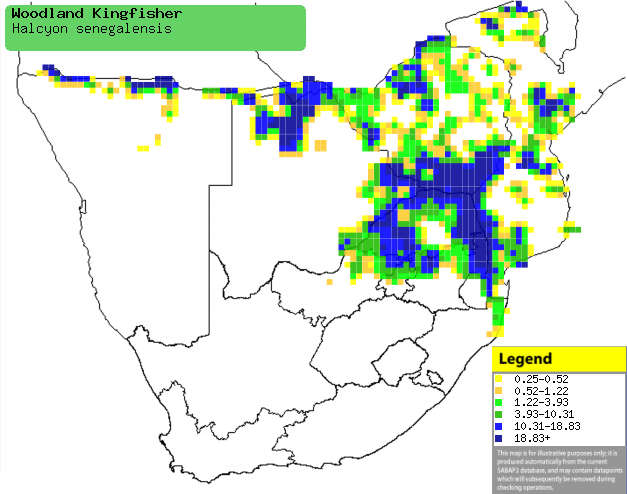|
Halcyon senegalensis (Woodland kingfisher)
Bosveldvisvanger [Afrikaans]; iNkotha (also
applied to Little bee-eater), uNongozolo [Zulu]; Muningi (generic
term for kingfisher) [Kwangali]; Tshololwana (generic term for
kingfisher) [Tsonga]; Senegalese ijsvogel [Dutch]; Martin-chasseur
du Sénégal [French]; Senegalliest [German]; Pica-peixe-dos-bosques
[Portuguese]; Halcyon senegaloides (Mangrove kingfisher)
Manglietvisvanger [Afrikaans]; uNongozolo [Zulu]; Mangrove-ijsvogel
[Dutch]; Martin-chasseur des mangroves [French]; Mangroveliest
[German]; Pica-peixe-dos-mangais [Portuguese]
Life
> Eukaryotes
>
Opisthokonta
> Metazoa
(animals) > Bilateria > Deuterostomia >
Chordata > Craniata > Vertebrata (vertebrates) > Gnathostomata (jawed
vertebrates) > Teleostomi (teleost fish) > Osteichthyes (bony fish) > Class:
Sarcopterygii (lobe-finned fish) > Stegocephalia (terrestrial vertebrates) >
Tetrapoda (four-legged vertebrates) > Reptiliomorpha > Amniota >
Reptilia
(reptiles) > Romeriida > Diapsida > Archosauromorpha > Archosauria >
Dinosauria (dinosaurs) > Saurischia > Theropoda (bipedal predatory
dinosaurs) > Coelurosauria > Maniraptora > Aves (birds)
> Order: Coraciiformes
> Family: Dacelonidae
The Woodland kingfisher is common across sub-Saharan Africa,
occupying a wide variety of woodland and savanna habitats. It is quite an
adaptable hunter, feeding mainly insects but also small vertebrates, such as
fish, snakes and even other birds! It is an intra-African migrant, arriving in
southern Africa around September-December, breeding then leaving for Central
Africa around March-April. It usually nests in tree cavities, either natural or
excavated by barbets or woodpeckers, laying 2-4 eggs incubated by both sexes.
The chicks grow rapidly, cared for by both parents, leaving the nest at about
18-24 days old. They remain dependent on their parents for about 5 more weeks
after fledging, after which they usually disperse.
Distribution and habitat
Common across sub-Saharan Africa, although absent from arid areas
such as the deserts of Somalia. In southern Africa it occurs in northern Namibia
(including the Caprivi Strip), northern and eastern Botswana, Zimbabwe,
Mozambique and north-eastern South Africa. It is highly adaptable,
occupying a wide range of woodland and savanna habitats, provided there are streams,
rivers or lakes. It also occurs in man-altered areas, such as parks, gardens and
farmland.
|
 |
|
Distribution of Woodland kingfisher in southern Africa,
based on statistical smoothing of the records from first SA Bird Atlas
Project (©
Animal Demography unit, University of
Cape Town; smoothing by Birgit Erni and Francesca Little). Colours range
from dark blue (most common) through to yellow (least common).
See here for the latest distribution
from the SABAP2. |
Call
Movements and migrations
Intra-African migrant, arriving in southern Africa from
September-December, going through its breeding cycle before leaving for Central
Africa in the period from March-April.
Food
It is quite an adaptable hunter, feeding mainly on insects,
supplemented with small vertebrates, such as fish, snakes and even other birds! It usually
hunts from a perch, searching for food. Once it spots prey it dives down to the
ground, grabs
the prey item with its bill then flies back up to its perch, where it usually
beats the animal to death. The following food items have been recorded
in its diet:
- Invertebrates
- Vertebrates
- reptiles
- amphibians
- birds
Breeding
- It usually nests in tree cavities, either natural or excavated by barbets
or woodpeckers, such as
Crested barbet,
Black-collared barbet,
Bearded woodpecker,
Bennett's woodpecker and
Golden-tailed woodpecker.
It also uses nest boxes and holes underneath the eaves of buildings.
- Egg-laying season is from about November-March, peaking from
December-January.
- It lays 2-4 eggs, which are incubated by both sexes for an
estimated period of 13-14 days.
- The chicks grow rapidly and are cared for by both parents, leaving the nest at
about 18-24 days old. They remain dependent on their parents for about 5
more weeks after fledging, after which they usually disperse.
Threats
Not threatened.
References
-
Hockey PAR, Dean WRJ and Ryan PG (eds) 2005. Roberts -
Birds of southern Africa, VIIth ed. The Trustees of the John Voelcker
Bird Book Fund, Cape Town.
|
